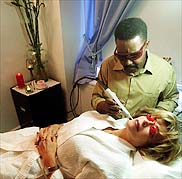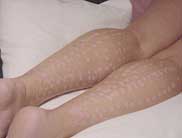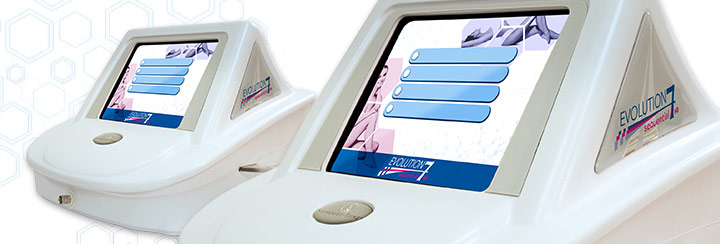News & Events
Are High-Tech Beauty Treatments Safe?
By ELIZABETH HAYT
A Manhattan woman of 29, who regularly visited a SoHo spa for chemical peels to keep her face acne-free, was used to mild flaking afterward. The treatment, using glycolic and salicylic acids, strips off a layer of skin. But a peel three months ago, the woman said, left her face so raw that it oozed blood for six days. Weeks later, she still looked as if she had windburn from skiing.
In October 2000, a senior executive at Salomon Smith Barney considered herself lucky to land an appointment with a visiting Hollywood facialist, who was offering skin treatments from a suite at the luxury Rihga Royal Hotel in Midtown. But her microderm abrasion treatment — a machine sprays aluminum- oxide crystals to sand off the top layers of skin lightly — was not what she had hoped for. "My face had burned patches," the woman said. "One of them was three inches in diameter on my cheek. I was terrified it would leave a scar. It's taken about a year to heal."
Last year, a Wall Street administrative assistant went to an Upper East Side spa to have hair removed by laser from her underarms. The procedure was extremely painful, she said, and four days later, she broke out in blisters and was treated for second-degree burns by a dermatologist. Months later, she said, she has cigar-size areas of discoloration. "They're pretty dark, so I can forget about wearing anything sleeveless," she added sadly.
All three tales — described by patients who asked not to be identified, to guard their privacy — illustrate a darker side to the mass consumption of new, high-tech cosmetic procedures like laser hair removal, chemical peels and microdermabrasion.
Originally developed by physicians, these treatments, which promise the dewy luster of youth, have in the last two years moved out from the fluorescent lights of doctors' offices and into the candlelighted, eucalyptus-scented interiors of skin-care salons and "wellness centers." Using powerful technologies like lasers and microdermabrasion machines, the treatments are being done by nonphysicians, everyone from facialists to massage therapists.
The result has been an increase in medical complications, according to the American Society for Dermatologic Surgery, which warns that many nonphysicians lack training — sometimes having only a one-day course. The dermatologists' group says that nearly half its 2,400 members have reported an increase in treating burns, scarring and other injuries caused by nonphysicans doing high-tech beauty procedures.
"A few years ago, we saw complications very infrequently," said Dr. David McDaniel, an assistant clinical professor of dermatology and plastic surgery at Eastern Virginia Medical School. "Now the equipment is more powerful, there's less supervision, less training, and more people are getting the services, which led to a fairly dramatic rise in people being injured, sometimes permanently."
Dr. Tina Alster, the director of the Washington Institute of Dermatologic Laser Surgery, in Washington, said, "Not a week goes by that I don't see a patient with either burns or pigmentary changes related to unscrupulous use of lasers and light sources."
The dermatologists' society last year began a campaign to have only physicians perform or directly supervise cosmetic treatments for hair and blood vessel removal, chemical peels, microdermabrasion and treatment of acne rosacea, an inflammation of the skin reminiscent of W. C. Fields' nose.
The issue is complicated. The dermatologists are not accusing nonphysicans of illegal practices. But regulations governing the new technologies vary widely among states and are sometimes unclear or conflicting within one state. The booming spa industry, which offers the high-tech treatments at 50 percent of doctors' fees or less, says physicians are threatened by the loss of patients and want to keep the lucrative beauty treatments for themselves.
"Everyone wants a piece of the pie," said Mary Bemis, the editor of American Spa magazine. "A lot of physicians saw a good amount of their business being taken away by aestheticians who started doing microdermabrasion and laser hair removal. The aestheticians argue that you couldn't get the kind of one-on-one personal attention from a physician's office. Beauty is where the money is."
Laser hair removal is a case in point. Since 1996, when the Food and Drug Administration approved the use of lasers for hair removal — an alternative to waxing and electrolysis — the treatments have become wildly popular. Last year, more than five million hair-removal treatments using laser and pulsed-light sources were performed, generating $1.3 billion, according to Medical Laser Insight, a trade newsletter. A majority of procedures are done by nonphysicians, for fees of a few hundred dollars, compared with a doctor's fee, which can be $1,000 or more.
The F.D.A. classifies hair-removal lasers as prescription devices, which can be sold only to physicians, dentists and other "licensed practitioners," an agency spokeswoman said. The states decide which licensed practitioners, including nurses and aestheticians (technically, these are people who do facials, tweezing and the like) may buy and use the machines.
Fifteen states — New Jersey is one — allow only physicians to use lasers. Seventeen states, New York among them, have varying rules about which nonphysicians may use the machines and whether or not they must be supervised by a doctor. The other states, including Ohio and Michigan, have no rules at all.
The discrepancies mean that Dr. David Goldberg, who practices dermatology in two states, does all the laser procedures at his office in Hackensack, N.J., but at his Upper East Side office, he hands over his hair-removal laser wand to his physician's assistant and nurses.
"Cosmetic laser surgery has no standards," Assemblyman Steven Sanders of Manhattan said. "It's almost as if it escaped notice. It burst on the scene and is below the radar screen of standards and regulations. There are thousands and thousands of individuals who avail themselves of these services, and there is no guarantee to consumers that they will be treated by someone who is qualified to perform."
Mr. Sanders plans to introduce a cosmetic-laser-surgery bill in the current Assembly session.

Photo - Philip Greenberg / NYT
SOFT LIGHT Ulyesses Evans demonstrates laser hair removal at the Advanced Skin Day Care Spa. No complaints of injuries have been made against the spa.
Last Memorial Day weekend, Terri Bowling, a Pittsburgh office worker, went to the Steliotes Dental-Medi Spa in McMurray, Pa., for laser hair removal on her lower legs, which she said were burned during treatment. She said the technician who did the procedure was trained by Kimberly Steliotes, a cosmetician (and Miss Pennsylvania, 1998), who is the wife of Dr. Ted Steliotes, a dentist and owner of the spa.
"It was burning so bad, I couldn't even get dressed afterward," said Ms. Bowling, who is suing for unspecified damages. "I couldn't stand my pants touching my skin." A photograph she intends to submit in court shows the back of her legs with a checkerboard of scar tissue. Dr. Karen Rosche, a plastic surgeon Ms. Bowling visited, said: "I was pretty appalled. She suffered a significant injury at the hands of someone who didn't have the training and expertise to do what they were doing."
Dr. Steliotes, owner of the spa, declined to comment on the lawsuit but said he had stopped offering laser hair removal.

Photo - Scott Goldsmith / NYT
Terri Bowling went to a spa for a laser hair removal on her lower legs. She said they were burned in treatment, and she is seeking damages. This is a picture she intends to submit in court.
Another lawsuit, against the Greenhouse Day Spas, a national chain, has been filed by Kim McMillon, a New York investment banker, who said she received a zebralike pattern of second-degree burns across the right side of her face after laser hair removal at a Greenhouse spa in Manhattan in February 2001. The procedure was done by an aesthetician. Ms. McMillon said she stopped the treatment midway through because her face felt on fire. That evening, she said, she "wiped off the charred skin."
The next morning, she went to an emergency room. A year later, scars are still somewhat visible under a layer of Dermablend, a thick make- up she uses. In an interview in her lawyer's office, Ms. McMillon, who is seeking $100 million in damages, appeared self-conscious about her appearance, constantly fussing with her shoulder-length hair to be sure it covered the right side of her face.
In court papers, Greenhouse denied it caused the burns and said Ms. McMillon assumed all risks of her $350 treatment.
There are about 20 brands of lasers, with names like Cool Glide and Gentlelase. All work similarly: a light source targets the melanin in a hair follicle to destroy it. A cooling gel may be applied to the surrounding skin to protect it from injury. Both the practitioner and the patient wear goggles to protect their eyes.
Manufacturers and distributors are supposed to verify that buyers, if they are not physicians, have medical oversight, but it is easy to circumvent the system. Ken Callison, the owner of Allied Health Association, a Denver-based supplier of high-tech beauty equipment, said that for a $600 annual fee, he offers a rent-a-medical-director program, so that nonphysicians can get a doctor to sign off on the purchase of a hair removal laser, and for $150 a year, they can buy $1 million worth of malpractice insurance. They may need it.
"We are seeing a lot of claims," said Daryl Stephens, president of Marine Agency in Maplewood, N.J., which sells insurance to skin-care specialists and the spa industry. "The kind of claims we're seeing are blistering and scarring and working on people who aren't good candidates. We are in the middle of revising our policies. The premiums are going to go up because the dollar amounts of claims are going up."
When a physician is affiliated with a spa or skin-care salon, it may be in name only. In 1998, Vanishing Point, a chain of seven laser-hair-removal centers, opened in New York, Miami and San Francisco, before going out of business two years later. Dr. Michael Gold, a dermatologist in Nashville, was an owner. Laser-hair-removal technicians performed the day-to-day procedures, with doctors available by phone in emergencies.
Dr. Gold said that safety was not a problem, citing data he collected from July to December 1998, when, he said, Vanishing Point treated 30,000 areas of patients' bodies with less than a 1 percent incidence of complications.
But a registered nurse who worked at a Vanishing Point center on West 16th Street in Manhattan from September to December 1998 said that she saw customers with small, rectangular burns caused by the laser machine. "There wasn't enough supervision," said the nurse, who did not want to be named because she was concerned about future employment discrimination. "It was a dangerous thing to be doing. But the public saw it as oh, so glamorous — `Oh, no more hair.' They weren't thinking about the risks."
Dr. Gold responded: "Everybody that treats anybody with hair removal will see someone burned every so often. If they did have a burn, those patients were taken care of, either by phone or a physician visit, which were all free."
Dr. Laurie Polis, a SoHo dermatologist, said a poorly trained technician might inadvertently use a laser to remove a blemish that could be a warning of cancer. "Having a laser and taking off an undiagnosed pigmented lesion is like having a gun in your hand," she said. "The pigment in a dangerous lesion is a signal to the dermatologist that the lesion needs surgical removal and biopsy. Having one of these self-proclaimed, so-called laserists remove the warning sign, and now depigmented malignancy can spread through the body to the brain and kill someone in later months or years."
In the survey conducted by the American Society for Dermatologic Surgery, the doctors reported seeing about 110 cases of injuries from laser hair removal performed by nonphysicians in the preceding year, about 95 cases of acne rosacea complications, 90 cases of chemical-peel complications and about 80 microdermabrasian injuries. The physicians' group said the numbers were an "alarming increase."
Although there is no comparable survey for negative outcomes when physicians perform laser hair removal, the rate, said Dr. William Coleman, clinical professor of dermatology at the Tulane University Health Sciences Center, is less than 1 percent. "It's not like it doesn't happen to a physician, but it's less likely," Dr. Coleman said. "If something goes wrong, you get early intervention, which keeps a problem from being a big problem."
However, Dr. Gold, the former Vanishing Point owner, rejects the conclusion of his peers that high-tech beauty should be done only by physicians. "I don't buy into that angle," he said. "It's a nice P.R. move. You only hear about skewed portions of the demographics. You don't fill out a survey unless you have something to say. Yes, there are more complications when things are done outside a dermatologist's office, but that doesn't mean they can't be done."
Cindy Barshap, the owner of Completely Bare, a Manhattan skin-care center that does pulsed-light hair removal, said: "I personally don't think doctors should be doing hair removal. The technicians are licensed aestheticians, and they do this 12 hours a day. You go to a podiatrist for fungus but not for a pedicure. What doctor wants to do hair removal? It says a lot about the doctor."
The one certainty is that the debate will sharpen as laser hair removal and other high-tech treatments beckon to a youth-obsessed population. One leading laser maker, Candela, predicts that the laser-hair- removal machines in use worldwide will grow from the present 7,000 to 10,000 or more in the next two and a half years.
"It provides complimentary income to physicians," Jerry Puorro, the company president, said of the treatments. "They don't have to deal with managed health care in terms of reimbursement. It's another revenue stream for the spa owner. They have all these people for manicures, pedicures and hair, so they already have a cosmetic consumer in place."
Want a New Career?
The American Institute of Education can put you on the fast track to a rewarding career. Stop dreaming about it and make it happen at AIE!
Want to learn more? Read Why Become An Electrologist to see why AIE's electrology program is right for you!
Electrology Program
AIE'S ELECTROLOGY PROGRAM is right for you!
The American Institute of Education can put you on the fast track to a rewarding career as a licensed electrologist.
Stop dreaming about it and make it happen at AIE!
Want to learn more? Read Why Become An Electrologist to see why AIE's electrology program is right for you!
In just four months, you could be earning $70 to $130 per hour and working whenever and wherever you want. AIE's Electrology Program can make it yours.
Electrolysis Reimagined

For many years those of us associated with electrolysis understood that epilators operated at a frequency of 13.5 megahertz. About twelve years ago Dectro International introduced its Platinum line of epilators that operate at 27 MHz. Our horizons were expanded. Their claim is that hair is permanently removed 25% faster and with a degree of comfort previously unheard of. So what are we to make of an epilator that operates at 6.68 MHz?
Meet the Graduates

At the American Institute of Education, we let our electrolysis graduates speak for us! Our state-of-the-art training leads to exciting, financially rewarding careers. Our graduates are some of the most sought after electrologists in the market.
Testimonials
I really loved school at American Institute of Education and I selected it because I heard it was the best program. The experience was amazing even from the first phone call with Ron where tuition, scholarships, program hours flexibility, online access, and timely information is all top notch. The curriculum is national standard and includes all the latest and greatest topics that are hot in the industry.
- Russ Cameron, owner/manager
Skin Sensations in Las Vegas
Follow AIE Electrology!
Connect with us on Facebook:
@electrologyschool





SHARE